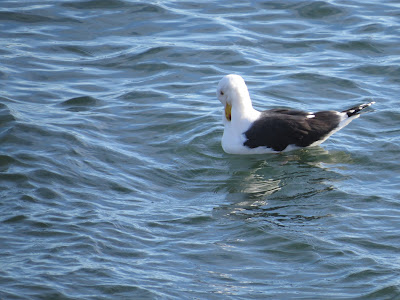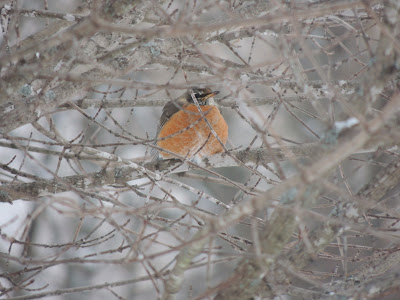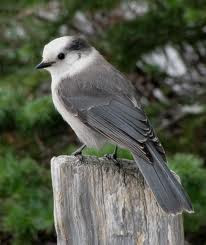- A group of goldfinches has many collective nouns, including a " 007", "charm", "rush", "treasury", and "vein" of goldfinches.
- These charming birds were everywhere. Originally we thought they were Yellow Bellied Fly Catchers but thanks to a birdwatcher in Nova Scotia we learned they were American goldfinches in their winter plumage. The American goldfinch changes to its breeding plumage by a full moult of its feathers. This bird molts twice a year, instead of once like the rest of the goldfinch species.
- It was odd but we didn't see a sparrow the whole time we were in Nova Scotia but we saw this little fellow repeatedly and in numbers.
- there were the odd Red Poll with them and they were about the same size.
- Depending on the light you could see yellow, lime green, rich brown and the contrasting black and white wings.
This year I am challenging my grand kids and their friends to a "Big Year". During 2013 we will be observing, identifying, and recording all our sightings of birds.
Thursday, January 31, 2013
31 American Goldfinch
30 Great Black Backed Gull
- A group of Great Black Backed Gulls is called a: Gullery / Screech / Squabble
- This is a real beautiful gull, the contrast from black back to the white head is very striking.
- This is one of the largest gulls, it will eat puffins and small ducks in a single gulp. yikes.
- They travel with Herring Gulls.
- They will fallow humpback whales and catch the fish coming to the surface to avoid the whale. How cool is that?
- I love watching them bob up and down on the waves. This large male was grooming himself. as if the water wasn't there.
- The tide at Digby is 27 feet. When it was out so were the birds.
Lily Lauren
Lily Lauren has been added to our Big Year hunters.
Although
she is a bit small to get round she is still part of the team. Number
11 of our grand-kids and is she ever looking around. Her sister Willow and I have been going out on walks in the morning and have seen some interesting birds. The weather up until we showed up has been unusually warm. Lots of birds that should have migrated somewhere warm are here. It has been cold for a week now and I bet they wish they were gone.Wednesday, January 30, 2013
29 Herring Gull
- A group of Herring Gulls is called a Gullery / Squabble.
- This is one of the most numerous birds out here in Nova Scotia. We see a Gullery every-time we see a Gull and yes they seem to be Squabbling.
- The Herring Gull is a very intelligent bird it has a very adapted vocalization and body language. It can communicate with just the tip of its head or the body movement and a sound it makes. The mature Herring Gull has a very distinct coloring but the trouble is the immature gull has a very large range of coloration making spotting other breeds of gulls very difficult.
- I was very surprised at what good swimmers and divers they were.
- We took the pictures of the Squabble at Digby. The lone gull was on a roof in Berwick the apple capital of Nova Scotia, also where Sean, Mel, Willow and now Lily live.
- Gulls eat everything. They are kind of like a Raven on the prairie.
- I love to watch them soar, catching thermals and rising up into the air.
28 American Robin
- A group of Robins is called a; Worm.
- We saw up to 40 Robins, a very large Worm in deed in Nova Scotia. It was -18 C here and they were really puffing themselves up.
- The robins usually eat insects and worms but will eat fruit and seeds when winter hits.
- They have a very distinct song. "When the red red robin goes bob bob bob-en along" as they say.
- In many places on the prairie the return of the Robin is the first sign of spring. I kind of like a place where they never leave.
Wednesday, January 16, 2013
27 Hungarian or Grey Partridge
- A group of Grey Partridge is a; Bevy / Brace / Covey.
- Grey or Hungarian Partridge are also called a Hun or Huns.
- A Hun is one of the best upland game birds to hunt. They are fast runners, quick take off, fast flyers, acrobatic and small, very difficult to shoot. They are very tasty, I remember as a teenager my brother and I would bag enough for our family of 8.
- There numbers over the years have been greatly reduced by the increase of predators, birds and fox.
- You still see them on grain fields a Bevy of 6 to 12. They like winter wheat fields. I love unmistakeable grey coloration.
Saturday, January 12, 2013
January 12th 2013;
- No new birds at my feeder, lots of ones we have already seen.
- This male Pine Grosbeak is so pink you wonder how it could survive from predator birds the way it stands out. Great Pic Jana.
- When we were in Alberta we were able to see 3 kiwis. They are usually flightless birds but these three have made their way for a visit.
- Vicki's brother Mark and his wife Nicki from New Zealand at hockey game. Hamish not in Picture.
Thursday, January 10, 2013
26; Grey Jay, Canada Jay or Whiskey Jack
- A group of Jays are called a; Band / Party.
- Grey Jays are omnivorous, meaning they eat seeds as well as meat and insects.
- Although they maybe one of the friendliest birds at a campsite (getting the nickname camp robber) they aren't so friendly with other birds stealing fledglings from their nest for food.
- Canada Jays collect food for the winter months. Kind of like squirrels.
- They lay 4 to 10 eggs early in spring, February or March, but have only one laying.
- After leaving the nest only one offspring is allowed in the parents territory. The remainder must cope for themselves. These remaining birds have only a 20% survival rate. Yikes!
- This bird was spotted by Machaela, Daphne and Gunnar at Uncle Mark's while checking his trap line. How cool is that?
25; Boreal Chickadee
- Thanks to Great Nana we can add this beloved bird to our list.
- A group of Chickadees is called a; Banditry.
- They mate for life and have 4 small eggs in an abandoned woodpecker hole about eye level.
- These birds are fairly rare but are not endangered because of their wide distribution and isolated habitat. Can be found at 5,500 feet in the Rockey Mountains and as far north as Alaska.
- Next the Mountain Chickadee.
24; Red Tailed Hawk
- A group of hawks is called a; Cast / Aerie / Kettle.
- Not many hawks winter in Canada. This bird does and does it well.
- This bird is a very adapt hunter. In the USA it is the number one bird used for falconry.
- Its feathers are used by Native Americans for ceremonials. It has a variation in color from light to dark on its back.
- It nest is made of sticks high atop of trees, cliffs or other structures.
- We saw this bird on its kill tearing it apart with its strong beak.
23; Mallard Duck
- A group of Mallard ducks is called a; Brace / Puddling / Flush
- Come on you guys its cold out there. One of my favorite memories is behind the Gateway Hotel, in High River Alberta, at the springs and source of The Little Bow River. Because of the springs the water stays open year round. Stuffed from bank to bank, 3 to 4 feet wide, were hundreds of ducks with the steam rising up and snow on the banks. You couldn't have put one more duck in there. We have pictures somewhere but I can't find them.
- The Mallard duck is a good size duck. It is a beautiful sport bird and a prize trophy. I love the green head and the blue, black and white bands on the wings.
- Mallards share both Allen's Rule and Bergmann's Rule. Allen's Rule states that polar species are generally larger in size and Bergmann's Rule states that outer appendages tend to be smaller in polar species. Therefore these ducks that winter here in Canada will be bigger and have smaller bills than those from warmer climates and those that go south for the winter. Cool.
- There is nothing better than a duck breast marinated, stuffed with jalapeno and goat cheese and cooked on the barbeque. Duck Poppers.
22: Morning Dove
- A group of Doves is called a: Dole / Flight / Piteousness
- This scruffy looking dove has been through snow and wind and looks like it could use a meal. Willow, dad and mom found this one near their home in Nova Scotia, Great job Willow.
- I love the sound of doves. You often see them flying together as a pair.
- This was the second bird Noah sent out of the arc and it brought back good news the water had receded. It has been known as the bird of peace and love.
- They make good pets and are a comforting bird.
- They also can be eaten. It would take a lot of them to fill me up and I think there are better meat sources out there.
21; Snowy Owl
- A group of owls is called a; Parliament.
- This nomadic bird is found in northern climates but can travel south for food and breeding.
- They lay their eggs on the ground and have 4 - 14 eggs.
- They normally have yellow eyes but as you can see this variation is beautiful blue as Eve my granddaughter would say.
- We saw one like this just outside Swift Current. Too cool.
- This one was taken on May 3rd near Meadow Lake SK.
20: Lesser Canadian Goose or Crackling Goose
- A group of geese is called a: Gaggle / Wedge
- In 2004 the Lesser Canadian goose became the Crackling Goose. This goose is a smaller version of the Canadian Goose, mini me. If you hunt you will know the difference just by packing it out. The big Canadians at one time were greatly reduced in numbers but now with good conservation have made a healthy come back.
Canadian and Crackling
- These birds mate for life. Many times I have had to stop along the road to let a mom and dad parade their young onto the other side of the road.
- It seems more and more of these hardy birds are not flying south for the winter. They seem to be able to find open water even in extreme weather in most major cities.
19; Bohemian Waxwing
- It was great time in Alberta but we didn't see as many birds as we wanted to. There was so much feed in the trees and bushes. Hats off to the people of Didsbury for growing bird friendly plants.
- There were hundreds of Cedar Waxwings so I knew if I watched and watched I would eventually see this beauty. It is easily distinguished from the Cedar by the yellow plumage on its wings. Seeing that plumage and distinguishing it from white was another story. At one time I must have seen a group of 500 Cedars/Bohemians. They were on a feeding frenzy, eating Mountain Ash berries. It doesn't take long for a group this big to clean up a tree.
- We had great temperatures all the time we were there 0C to +8C.
- Like the Cedar, this bird can fly at altitudes of 20,000 feet. So if the feeding is better in another town they can easily pack up and go. So if you see them take some pictures for tomorrow they could be gone.
Saturday, January 5, 2013
18; Cedar Waxwing
- We have stayed at Vicki's sisters house in Didsbury Alberta for the last week. The town has an abundance of trees and bushes for birds to feed on. It is no wonder we saw hundreds of these birds feasting on Mountain Ash.
- This fast flying bird travels at unusually high altitudes. It has a pleasant vocalization. The nesting pattern has them building more than one nest in an area lay 4-6 eggs and incubating in 14-15 days.
- People say they have seen these bird getting drunk on berries to the point of falling out of the tree.
- The Bohemian Waxwing is said to travel with them in smaller numbers. I have yet to confirm this. My eyes will be on the trees until I do.
Friday, January 4, 2013
17; Northern Raven
- A group of Ravens is called a: Unkindness.
- On our drive from Manitoba to Alberta we saw 12-14 dead deer along the road. At each of these sites we saw 4-5 Ravens feeding on carrion. The Northern Raven is an opportunist and scavenger.
- This bird is an omnivorous and is known to mate for life. Which is long up to 40 years. Speaking well of its large brain and having the ability to adjust to extreme climatic weather conditions. 8 sepcies are found around the world, the Northern is the one we see.
- They have a large range of vocalizations. They are aggressive and have been known to steal from fox, wolves and bears. Hunters and trappers will use their calls to find kills for baiting and trapping fur bearing animals.
- It has a very divers vocalization for communication. My favorite is a musical sound like that of a child's bike bell only a bit deeper in tone.
- These birds have a lot of history as evil watchers to creators to the first bird that Noah let out of the arc to search for land.
Wednesday, January 2, 2013
16 Jan 2nd 2013
- As expeted we were able to see some preditor birds on our journey to Alberta.
- 16; Bald Eagle
- A group of eagles is called a; Convocation.
- The Bald Eagle doesn't get its white head until it is mature at 5 years. The immature Bald is very similar to the Golden Eagle but the Golden has white plumage on its tail and less feathers on its legs. The Bald Eagle can have an impressive wing span of up to 7.5 feet.
- We took the first picture just outside Swift Current. At first we thought it was a mature Golden Eagle because of its size, but after studying the picture and seeing a mature Bald close by we recognized it as an immature Bald. What a wing span when it took off. It was feeding on a dead deer with some Ravens.
- The Bald Eagle is a powerful bird and has been known to carry off cats, dogs, fish, snakes and folk lore says children. It kills from above with landing on and using its talons to spear its pray.
Subscribe to:
Comments (Atom)
































